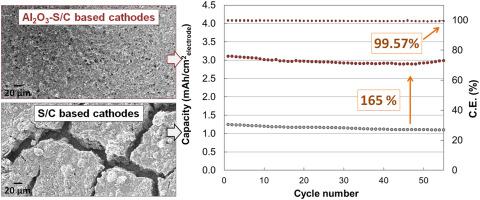Materials Today Energy ( IF 9.0 ) Pub Date : 2020-10-24 , DOI: 10.1016/j.mtener.2020.100567 E. Azaceta , S. García , O. Leonet , M. Beltrán , I. Gómez , A. Chuvilin , A.R. Mainar , J.A. Blazquez , M. Knez

|
Lithium-sulfur (Li-S) batteries are the most promising candidates for succeeding lithium ion batteries. However, they present some challenges which should be faced to increase its commercial possibilities as detrimental mechanisms during operation (e.g. shuttle effect, low capacity retention, anode corrosion, and so on) and sulfur cathode processing limitations (e.g. poor mechanical stability of S cathodes, defects, low S loading, and so on). Atomic layer deposition (ALD) with alumina (Al2O3) has been extensively applied to sulfur cathode surfaces to improve the electrochemical behavior of Li-S technology as it minimizes discharge product dissolution and hence, it reduces detrimental mechanisms during operation. However, the improvement of sulfur cathode processing still remains unsolved even high-cost approaches have been proposed in the state of the art which unfortunately are not viable for realistic applications. In the present work, for first time, ALD in a fluidized bed reactor (FBR) is carried out to coat sulfur-carbon (S/C) composite particles with Al2O3 before electrode manufacturing. The present approach provides a precise control of S/C composite agglomeration, which improves sulfur cathode processing while maintaining the well known satisfactory operational mechanisms related to Al2O3 coating. We reported on the economic FBR-ALD technique in a promising strategy for high specific energy density Li-S battery with an increased sulfur loading being, double of that obtained for a standard sulfur cathode (3.6 vs. 1.8 mgsulfur cm−2).
中文翻译:

粒子原子层沉积是提高Li-S电池能量密度的有效方法
锂硫(Li-S)电池是成功的锂离子电池最有希望的候选者。但是,它们带来了一些挑战,应该增加其商业可能性,因为操作过程中会产生有害的机制(例如,往复效应,低容量保持率,阳极腐蚀等)以及硫阴极工艺的局限性(例如,S阴极的机械稳定性差,缺陷,低S负荷等)。氧化铝(Al 2 O 3)的原子层沉积(ALD))已广泛应用于硫磺阴极表面,以改善Li-S技术的电化学性能,因为它最大程度地减少了放电产物的溶解,因此减少了运行过程中的有害机理。然而,即使在现有技术中已经提出了高成本的方法,但仍无法解决改进硫阴极工艺的问题,但是不幸的是对于现实的应用是不可行的。在本工作中,首次在流化床反应器(FBR)中进行ALD,以用Al 2 O 3覆盖硫碳(S / C)复合颗粒在电极制造之前。本方法提供了对S / C复合物附聚的精确控制,这改善了硫阴极工艺,同时保持了与Al 2 O 3涂层有关的众所周知的令人满意的操作机理。我们报道了一种经济的FBR-ALD技术,该技术用于高比能量密度Li-S电池,其硫负载增加了,是标准硫阴极所获得的两倍(3.6与1.8 mg硫cm -2),这是一种有前途的策略。











































 京公网安备 11010802027423号
京公网安备 11010802027423号